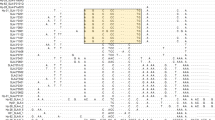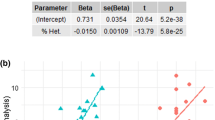Abstract
Hereditary cataract is a common ocular disorder in the purebred dog population and is a leading cause of visual impairment and blindness in dogs. Despite this, little is known to date about the genetics underlying this condition. We have used a genome-wide association study and targeted resequencing approach to identify a novel locus for cataracts in the Australian Shepherd breed of dog, using dogs that are clear of an HSF4 mutation, previously identified as the major susceptibility locus in this breed. Cataract cases were defined as dogs with bilateral posterior cataracts, or bilateral nuclear cataracts. Controls were at least 8 years of age with no evidence of cataracts or other ocular abnormality. Using 15 bilateral posterior polar cataract cases and 68 controls, we identified a genome-wide statistical association for cataracts in the Australian Shepherd on canine chromosome 13 at 46.4 Mb (P value: 1.5 × 10−7). We sequenced the 14.16 Mb associated region in ten Australian Shepherds to search for possible causal variants underlying the association signal and conducted additional fine-mapping of the region by genotyping 28 intronic variants that segregated correctly in our ten sequenced dogs. From this analysis, the strongest associated variants were located in intron 5 of the SCFD2 gene. Further study will require analysis of additional cases and controls and ocular tissue from dogs affected with bilateral cataracts that are free of the HSF4 mutation.

Similar content being viewed by others
References
Astle W, Balding D (2009) Population structure and cryptic relatedness in Genetic Association Studies. Stat Sci 24:451–471
Davidson MG, Nelms SR (1999) Diseases of the lens and cataract formation. In: Gelatt KN (ed) Veterinary Ophthalmology, 3rd edn. Lippincott/Williams & Wilkins, Philadelphia, pp 797–825
Downs LM, Hitti R, Pregnolato S, Mellersh CS (2014) Genetic screening for PRA-associated mutations in multiple dog breeds shows that PRA is heterogeneous within and between breeds. Vet Ophthalmol 17:126–130
Forman OP, De Risio L, Mellersh CS (2013) Missense mutation in CAPN1 is associated with spinocerebellar ataxia in the Parson Russell Terrier dog breed. PLoS One 8:e64627
Gajjar D, Jozwiak A, Swiezewska E, Alapure B, Parmar T, Johar K, Vasavada AR (2009) Quantification of dolichol in the human lens with different types of cataracts. Mol Vis 15:1573–1579
Gelatt KN, MacKay EO (2005) Prevalence of primary breed-related cataracts in the dog in North America. Vet Ophthalmol 8:101–111
Kahrizi K, Hu CH, Garshasbi M, Abedini SS, Ghadami S, Kariminejad R, Ullmann R, Chen W, Ropers HH, Kuss AW, Najmabadi H, Tzschach A (2011) Next generation sequencing in a family with autosomal recessive Kahrizi syndrome (OMIM 612713) reveals a homozygous frameshift mutation in SRD5A3. Eur J Hum Genet 19:115–117
Karlsson EK, Lindblad-Toh K (2008) Leader of the pack: gene mapping in dogs and other model organisms. Nat Rev Genet 9:713–725
Li H, Durbin R (2009) Fast and accurate short read alignment with Burrows-Wheeler transform. Bioinformatics 25:1754–1760
Mellersh CS, Pettitt L, Forman OP, Vaudin M, Barnett KC (2006) Identification of mutations in HSF4 in dogs of three different breeds with hereditary cataracts. Vet Ophthalmol 9:369–378
Mellersh CS, Graves KT, McLaughlin B, Ennis RB, Pettitt L et al (2007) Mutation in HSF4 associated with early but not late-onset hereditary cataract in the Boston Terrier. J Hered 98:531–533
Mellersh CS, McLaughlin B, Ahonen S, Pettitt L, Lohi H et al (2009) Mutation in HSF4 is associated with hereditary cataract in the Australian Shepherd. Vet Ophthalmol 12:372–378
Purcell S, Neale B, Todd-Brown K, Thomas L, Ferreira MA et al (2007) PLINK: a tool set for whole-genome association and population-based linkage analyses. Am J Hum Genet 81:559–575
Rubin LF (1989) Inherited eye diseases in purebred dogs. Williams & Wilkins, Baltimore, p 272
Thorvaldsdóttir H, Robinson JT, Mesirov JP (2013) Integrative Genomics Viewer (IGV): high-performance genomics data visualization and exploration. Brief Bioinform 14:178–192
Van der Auwera GA, Carneiro M, Hartl C, Poplin R, del Angel G et al (2013) From FastQ Data to high-confidence variant calls: the genome analysis toolkit best practices pipeline. Curr Protoc Bioinform 43:11.10.1–11.10.33
Acknowledgments
We would like to thank all owners for providing samples from their dogs for this study. We also thank Saija Ahonen and Hannes Lohi (University of Helsinki, Finland) for provision of samples for the study. We would like to thank the Australian Shepherd Health & Genetics Institute, Inc. for their assistance with sample collection, study publicity and financial contributions. This work was funded by Morris Animal Foundation First Award grant D10CA-303. In addition to the Australian Shepherd Health & Genetics Institute, we would also like to thank the Orthopedic Foundation for Animals and the American Spaniel Club Foundation for their sponsorship of the study. SLR, LP, BM, CAJ and CSM are supported by the Kennel Club Genetics Centre at the Animal Health Trust. We thank the High-Throughput Genomics Group at the Wellcome Trust Centre for Human Genetics (funded by Wellcome Trust grant reference 090532/Z/09/Z and MRC Hub grant G090074791070) for the generation of the sequencing data. We also thank Claudia Hartley (BVSc CertVOphthal DipECVO MRCVS) for assisting with case definitions and Oliver Forman and Mike Boursnell for technical and bioinformatics assistance.
Author information
Authors and Affiliations
Corresponding author
Electronic supplementary material
Below is the link to the electronic supplementary material.
Rights and permissions
About this article
Cite this article
Ricketts, S.L., Pettitt, L., McLaughlin, B. et al. A novel locus on canine chromosome 13 is associated with cataract in the Australian Shepherd breed of domestic dog. Mamm Genome 26, 257–263 (2015). https://doi.org/10.1007/s00335-015-9562-2
Received:
Accepted:
Published:
Issue Date:
DOI: https://doi.org/10.1007/s00335-015-9562-2




